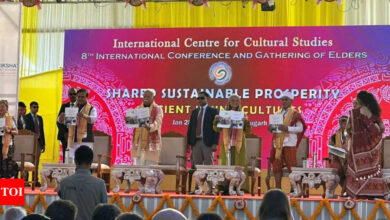India
Rlv: Isro reusable launch vehicle’s landing experiment successful; RLV closer to orbital re-entry mission | India News

[ad_1]
BENGALURU: The Indian Space Research Organisation (Isro) early on Sunday successfully conducted the reusable launch vehicle (RLV) autonomous landing mission or RLV-LEX at the Aeronautical Test Range (ATR) in Challakere, Chitradurga, some 220km from Bengaluru. The space agency used a scaled down version of the RLV technology demonstrator (RLV—TD).
“It went on exactly as planned and all parametres were met,” S Unnikrishnan Nair, director, Vikram Sarabhai Space Centre (VSSC), told TOI.
The RLV-LEX demonstrated one of the critical technologies — the approach and autonomous landing on a runway and has put the RLV programme one step closer to an orbital re-entry experiment (ORE).
On Sunday, the vehicle was carried using the Indian Air Force’s Chinook helicopter to an altitude of 4.5km and released at a distance of approximately 4km to 5km ahead of the runway with a horizontal velocity. After the release, the RLV glided, navigated towards the runway and carried out a conventional autonomous landing with a landing gear.
Nair had told TOI earlier that once Isro successfully completed the RLV-LEX and validated the software, landing gear and get data on how the aerodynamics sensors worked to manoeuvre the aircraft and bring it back to the intended spot on the runway and other critical technologies, it would be ready for ORE, for which the RLV will be scaled up.
As per Isro, in ORE, a wing body called Orbital Re-entry vehicle (ORV) will be taken to an orbit by an ascent vehicle derived from the existing GSLV and PSLV stages and stay in orbit for a stipulated period, re-enter and land in a runway autonomously with a landing gear.
Before the RLV-LEX Isro had done the RLV-TD HEX-01 (hypersonic experiment) mission in which it validated autonomous navigation, guidance & control, reusable thermal protection system and re-entry mission management. Now that LEX is done, Isro will need to integrate both for the ORE.
Carried out on May 23, 2016, the RLV-TD HEX was a 770-second suborbital flight and designed to land on sea. The experimental mission saw the HS9 solid rocket booster carrying RLV-TD to a height of about 65km from where the vehicle began its descent followed by atmospheric re-entry at around Mach 5 (five times the speed of sound).
Isro, which has been working on this technology for more than a decade, decided to develop it primarily to address the cost and time issues. “The cost of access to space is the major deterrent in space exploration and space utilisation. A reusable launch vehicle is the unanimous solution to achieve low cost, reliable and on-demand space access,” Isro has said.
However, mastering this technology will provide multiple other benefits, including in development of different types of launch vehicles, space transportation and so on. While the ORE will be a major milestone, the RLV-TD is only a technology demonstrator and the development of an actual re-usable launch vehicle will take more time.
“It went on exactly as planned and all parametres were met,” S Unnikrishnan Nair, director, Vikram Sarabhai Space Centre (VSSC), told TOI.
The RLV-LEX demonstrated one of the critical technologies — the approach and autonomous landing on a runway and has put the RLV programme one step closer to an orbital re-entry experiment (ORE).
On Sunday, the vehicle was carried using the Indian Air Force’s Chinook helicopter to an altitude of 4.5km and released at a distance of approximately 4km to 5km ahead of the runway with a horizontal velocity. After the release, the RLV glided, navigated towards the runway and carried out a conventional autonomous landing with a landing gear.
Nair had told TOI earlier that once Isro successfully completed the RLV-LEX and validated the software, landing gear and get data on how the aerodynamics sensors worked to manoeuvre the aircraft and bring it back to the intended spot on the runway and other critical technologies, it would be ready for ORE, for which the RLV will be scaled up.
As per Isro, in ORE, a wing body called Orbital Re-entry vehicle (ORV) will be taken to an orbit by an ascent vehicle derived from the existing GSLV and PSLV stages and stay in orbit for a stipulated period, re-enter and land in a runway autonomously with a landing gear.
Before the RLV-LEX Isro had done the RLV-TD HEX-01 (hypersonic experiment) mission in which it validated autonomous navigation, guidance & control, reusable thermal protection system and re-entry mission management. Now that LEX is done, Isro will need to integrate both for the ORE.
Carried out on May 23, 2016, the RLV-TD HEX was a 770-second suborbital flight and designed to land on sea. The experimental mission saw the HS9 solid rocket booster carrying RLV-TD to a height of about 65km from where the vehicle began its descent followed by atmospheric re-entry at around Mach 5 (five times the speed of sound).
Isro, which has been working on this technology for more than a decade, decided to develop it primarily to address the cost and time issues. “The cost of access to space is the major deterrent in space exploration and space utilisation. A reusable launch vehicle is the unanimous solution to achieve low cost, reliable and on-demand space access,” Isro has said.
However, mastering this technology will provide multiple other benefits, including in development of different types of launch vehicles, space transportation and so on. While the ORE will be a major milestone, the RLV-TD is only a technology demonstrator and the development of an actual re-usable launch vehicle will take more time.
#Rlv #Isro #reusable #launch #vehicles #landing #experiment #successful #RLV #closer #orbital #reentry #mission #India #News






